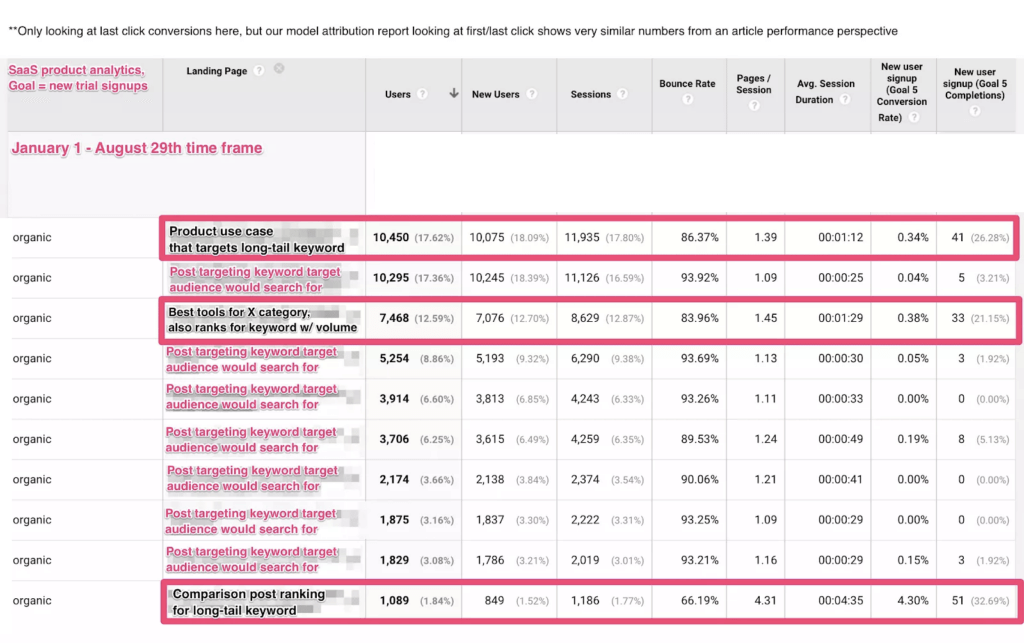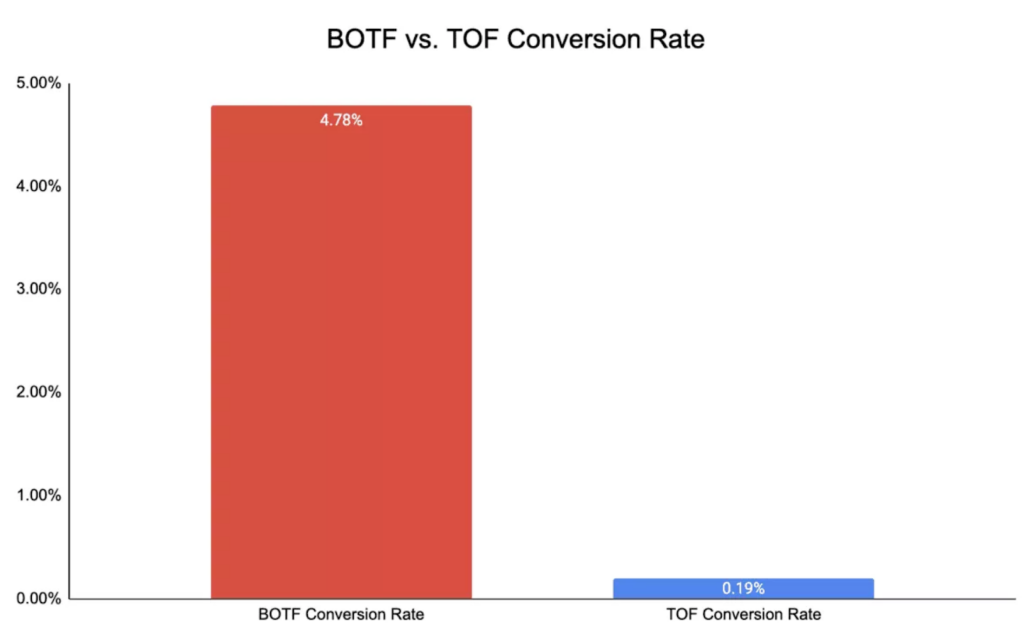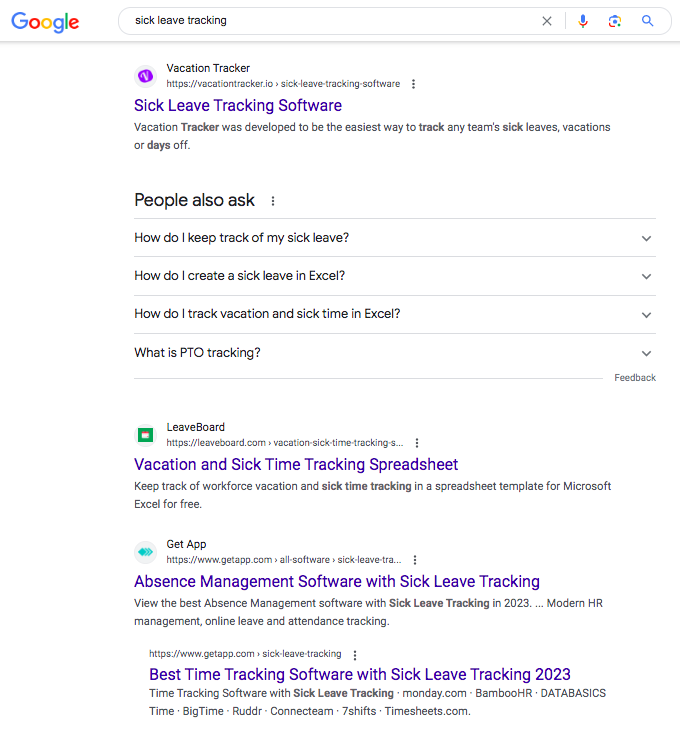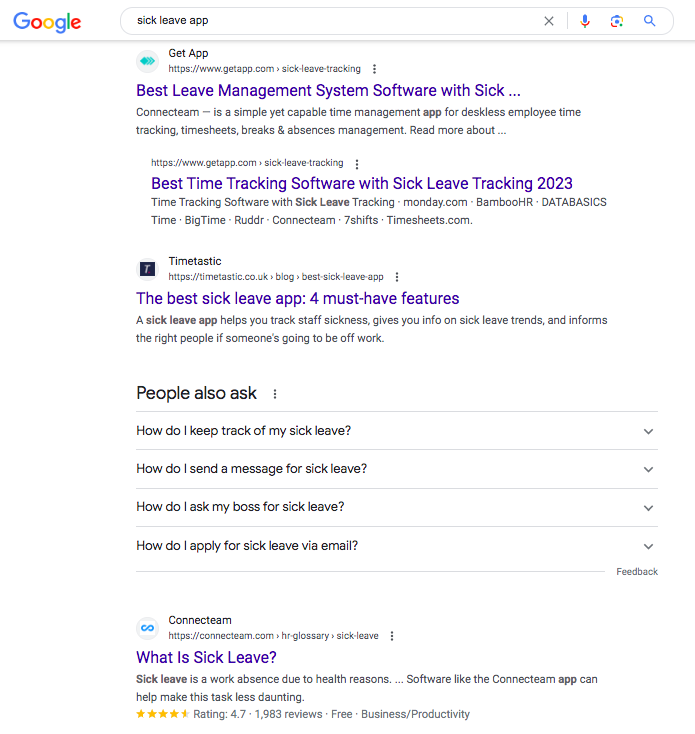In this article, we share the two key actions that — based on our experience measuring conversions from hundreds of blog posts across dozens of clients — have the highest impact on improving blog conversion rates:
- Prioritizing ranking for SEO keywords with high buying intent
- Selling your product or service through your blog content
Below we’ll explain why focusing on these two things will improve your conversion rates more than typical CRO “tips and tricks” that marketers discuss (e.g. A/B testing, analyzing heatmaps, adding social proof and testimonials, etc.).
Then, before we wrap up, we’ll share some additional resources and factors to consider for execution, including:
- Why you should target individual keywords with dedicated blog posts
- How to measure blog conversion rates in Google Analytics 4
- What a good blog conversion rate is
Note: If you’d like help improving your blog conversion rate, you can learn more about our agency here and reach out about working with us here.
Action #1: Prioritize Ranking for SEO Keywords with High Buying Intent
Most businesses, in-house marketers, content marketing agencies, and SEO agencies view blogs strictly as a channel for getting potential customers in their “conversion funnel,” not as an asset for directly selling products and services.
In practice, this means they prioritize keywords that have high search volume, but little buying intent. For example, if you sell social media management software, this might mean targeting keywords such as “how to stand out on Twitter” or “social media ad trends.”
This approach is based on the assumption that with enough traffic — and by implementing conversion rate optimization practices such as providing a good user experience, including calls to action, etc. — conversions will inevitably follow.
However, having measured conversion rates for hundreds of blog posts for dozens of clients, this assumption is flawed and untrue.
Specifically, while these keywords could potentially be searched for by your audience and may have high search volumes, searchers of these terms show no clear indication that they have intent to buy social media management software. (If they did, they’d be more likely to Google a term with clear buying intent such as “best social media management software” or “social media management app.”)
As a result, by our measures, these top of funnel keywords have very low conversion rates. And trying to solve that by making CRO tweaks to your site (e.g. adding popups with CTAs, offering a lead magnet, adding long sections selling your product or service, etc.) is unlikely to make much of a difference because the website visitors coming in from those keywords are either a) too early in the customer journey to convert or b) flat-out not on the market for what you sell.
This point is neatly summarized in this analytics screenshot from our article on Pain Point SEO (our agency’s foundational SEO content strategy):

The right most column shows new user signups for each of the URLs listed. The three boxed posts follow the Pain Point SEO approach and rank for keywords with high buying intent. The rest rank for something the target audience could search for, but not a high buying intent keyword.
The new user signups from the three Pain Point SEO posts are hundreds of percent higher.
We also showed this at a larger scale in an analysis of 60+ posts for our client Geekbot:

The posts targeting high buying intent keywords (which we’ve traditionally referred to as “bottom of funnel”) didn’t just convert a bit better than the higher-volume-lower-intent posts, they converted 2400% better. In that case study, you can read about how the higher conversion rates more than made up for any differences in search volume or traffic between the two buckets.
This is why, in our experience, prioritizing high buying intent keywords is by far the most impactful way to boost conversion rates. If you do nothing else — and frankly, even if you don’t have super high-quality content — simply ranking for keywords where people are actively looking to buy what you sell will inevitably drive more conversions than ranking for low intent keywords.
Regarding how you can actually execute this, check out these two articles which lay out our agencies processes in detail:
- Choosing keywords — SEO Keyword Strategy: How to Prioritize Based on Buying Intent to Drive More Conversions
- Ranking for those keywords — SEO Content Writing: A 5-Step Process You Can Follow
Once you have that down, the other key part of improving website conversion rates is writing compelling product or sales copy to convert visitors into customers (this includes blog posts).
Action #2: Sell Your Product or Service In Each Piece of Content
Many SEO’s and content marketers barely discuss the company’s product or service inside of the blog content they write. They’ll sometimes glancingly mention and link to a service or product page in their content, but they often just rely on design elements of the page (e.g. pop-ups, email list opt-in forms, CTA graphics, etc.) to “take care of conversions.”
We think this mistake is related to the problem discussed above — the tendency to prioritize keywords with high traffic potential but low buying intent. The advice that’s typically paired with that practice is to “not be too salesy” in your blog content: “just give the customer advice and value and they’ll like your brand and (fingers crossed) remember you later when they need to buy” (not likely).
In our experience, even if you’re writing about top of funnel topics that aren’t product-focused, you need to weave in a compelling discussion of your product or service if you want your content to convert.
Particularly if you focus on high buying intent keywords, this necessitates discussing your product or service in order to meet search intent.
If someone is searching for “best social media management software”, their intent is to learn about the details of various options. These are potential customers that want to understand the value propositions of this software option versus that one, how they compare, which is better for whom, and more.
Discussing those product related ideas isn’t “being salesy” for this type of search query, it’s just fulfilling search intent! So, whether you go after that keyword with a landing page or a blog post, the content needs to discuss your product or service in-depth, much like a sales page.
We’ve written at length about the challenges of doing this well, and how we execute this for our clients. Check out our post on Pain Point Copywriting for a deep dive on writing copy that converts.
Additional Resources and Factors to Keep In Mind
Target Each High Intent Keyword with a Single, Dedicated Page That Deeply Satisfies Search Intent
People in search engine optimization often try to target many different keywords with a single web page. But search engines don’t reward this approach like they used to. As algorithms have evolved, the approach of trying to rank for a bunch of keywords (especially competitive buying intent keywords) with a single blog post rarely works.
One of our key learnings in recent years (and a differentiator of our agency’s strategy) is that the best way to get top positions for high intent keywords is to create a dedicated page for each one — even when keywords have very similar meanings.
For example, consider the keywords “sick leave tracking” and “sick leave app.” You can imagine that the intent behind these two search terms is nearly identical: searchers are looking for a tool to track employee sick leave.
But when you look at search results for these two terms, the top results are different.
Here are the results for “sick leave tracking”:

And here are results for “sick leave app”:

Although intent is very similar, Google is ranking different pages for these terms, which indicates an opportunity to create dedicated pages to go after each of these keywords.
As we discussed in our conversation with Bernard Huang of Clearscope, you only get one SEO title, one H1 heading, one meta description, etc. If you try to rank for multiple target keywords with one piece of content, often it will only end up ranking for one of those keywords (or worse, you won’t match the intent of any individual keyword, and you won’t end up ranking for any of them).
Note: We’ve documented the exact process we use when analyzing search engine results pages (SERPs) for target keywords in our post on SEO content writing.
Measuring Blog Conversions in Google Analytics
Clients and the companies we speak with ask us all the time about how we track conversions in Google Analytics, so we’ve created two long-form pieces of content that explain how to do this.
First, we wrote a step by step tutorial on how to set up conversion tracking in Google Analytics 4 (GA4). Check that out for the full explanation.
Second, we created a long-form video walkthrough explaining the process:
What Is a Good Blog Conversion Rate?
Over the years, we’ve had a number of conversations with clients where they’ve expressed that they feel their organic conversion rate is low compared to what they thought was good.
We think this is partially a result of companies using paid conversion rates as a benchmark for overall organic conversion rates. For example, they might see that their average conversion rate from Google Ads is ~3%, while their average overall conversion rate from organic search is somewhere in the 0.1%-0.3% range, and then conclude that their organic conversion rate is very low.
However, as we discussed at length in our deep dive video on average blog conversion rates, oftentimes the way companies look at their organic conversion rates is flawed. Specifically, they don’t segment out the different parts of their site and different mediums of traffic which skew conversion rates and make them seem higher or lower than they should be.
To gain a deeper understanding of what makes a good conversion rate, and how to more accurately measure your conversion rates from SEO, check out the video:
In the video, we share conversion rate data from two different clients of ours — both a mid-market/enterprise demo based SaaS company and a B2SMB self service SaaS company — and show how we’re getting 2%+ average conversion rates on our blog posts and compare those stats to how their sites convert overall from organic.
We share data on what we’ve seen for average blog conversion rates and explain what we think a good conversion rate target should be for each individual blog post.
In general, a good SEO conversion rate for pages ranking for bottom of funnel keywords is between 1%–5%. Anything above that is great. And in general, for an entire blog or content operation that largely focuses on bottom of funnel pieces, a conversion rate of 0.5%– 2% from visitor to lead, trial start, or eCommerce sale is good.
Lastly, we share 3 examples of us outranking landing pages with blog posts and debate why we think blog posts are usually the better approach for high intent keywords — and why we think they may have higher conversion rates (even if the landing page were to rank higher than our blog post).
Learn More About Our SEO and Content Marketing Agency
- Our Agency: If you want to hire us to execute an SEO-focused content strategy built around driving lead generation and sales, not just traffic, you can learn more about working with us here.
- Join Our Content Marketing Team: If you would love to do content marketing in this way, we’d love to have you apply to join our team as a content strategist or writer.
- Our Content Marketing Course: Individuals looking to learn our agency’s content marketing strategy and become better marketers, consultants, or business owners can join our private course and community, taught via case studies, and presented in both written and video content formats. We include several details and examples not found on this blog. Our course is also built into a community, so people ask questions, start discussions, and share their work in the lesson pages themselves, and we, along with other members, give feedback. Learn more here.








